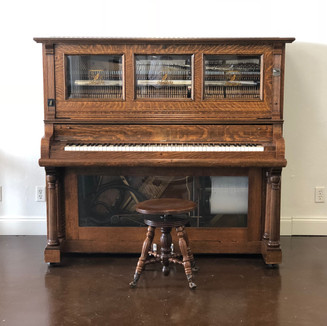A look at player pianos
- Jennifer Kampermann

- May 30, 2018
- 2 min read
This rare find of a piano is now on consignment at our gallery for a lovely client of ours. It's a beautiful Cremona Player Piano that we estimate was built in the early part of the 20th century.
Cremona Player Pianos were made by Smith, Barnes & Strohber, a successful piano manufacturer in Chicago, Illinois. Then, The Marquette Piano Company, of Chicago, Illinois, installed all the player components into those pianos. The pianos were coin operated and primarily used in commercial locations. With the 2018 Piano Technicians Guild convention coming up, it reminded me of last year's conference when we were in St. Louis, and I got to see a player piano in action when we visited the Scott Joplin House.
A player piano which is also known as a pianola contains pneumatic or electro-mechanical mechanisms so that the piano operates on its own using pre-programmed music recorded on a roll of perforated paper. Development of the player piano was between 1900-1910, and it reached its peak between 1920-1930. The advent of radio during the same era is what caused the eventual decline in popularity, and the stock market crash of 1929 virtually wiped out production altogether. However, the QRS piano roll company managed to survive and is still business today as QRS Music Technology Inc.
During the early 1950s, the player piano saw a bit of revitalization when a number of collectors in England and the United States began to rescue them. In America, Harvey Roehl was so enthused by the pianos that in 1961 he published a book called Player Piano Treasury. The book sold tens of thousands of copies and was followed by books on how to rebuild and restore these instruments. Harvey Roehl's Vestal Press was a major driving force in raising awareness of the player piano within the general population.
In England, Frank Holland formed his collection when he was working in Canada. When he returned to England, he found a number of like-minded enthusiasts and started to hold meetings at his house in west London. In 1959 it became official when the "The Player Piano Group" was formed. Then in the early 1960s, Frank Holland established the British Piano Museum, which is now the Musical Museum in Brentford, England.
The revival was so great that in the 1960's production started again. Aeolian revived the pianola, however, this time in a small spinet piano more suited to post-war housing. Other manufacturers followed, and production has continued intermittently ever since. Recently, there has been a greater focus on rebuilding the pianos. In the past, enthusiasts could get by with a little patching, but the repair requirements have slowly risen, although even to this day it is possible to find original 1920s instruments that still work - a tribute to their quality, and an indication of their continued popularity.










Comments